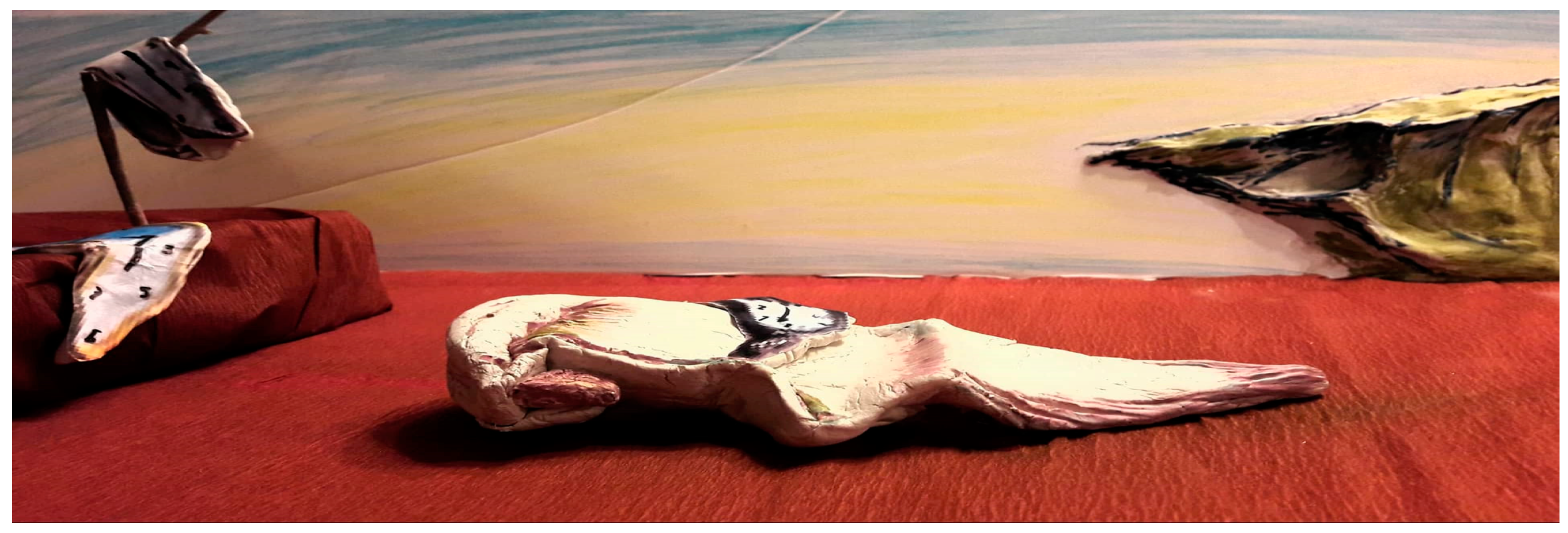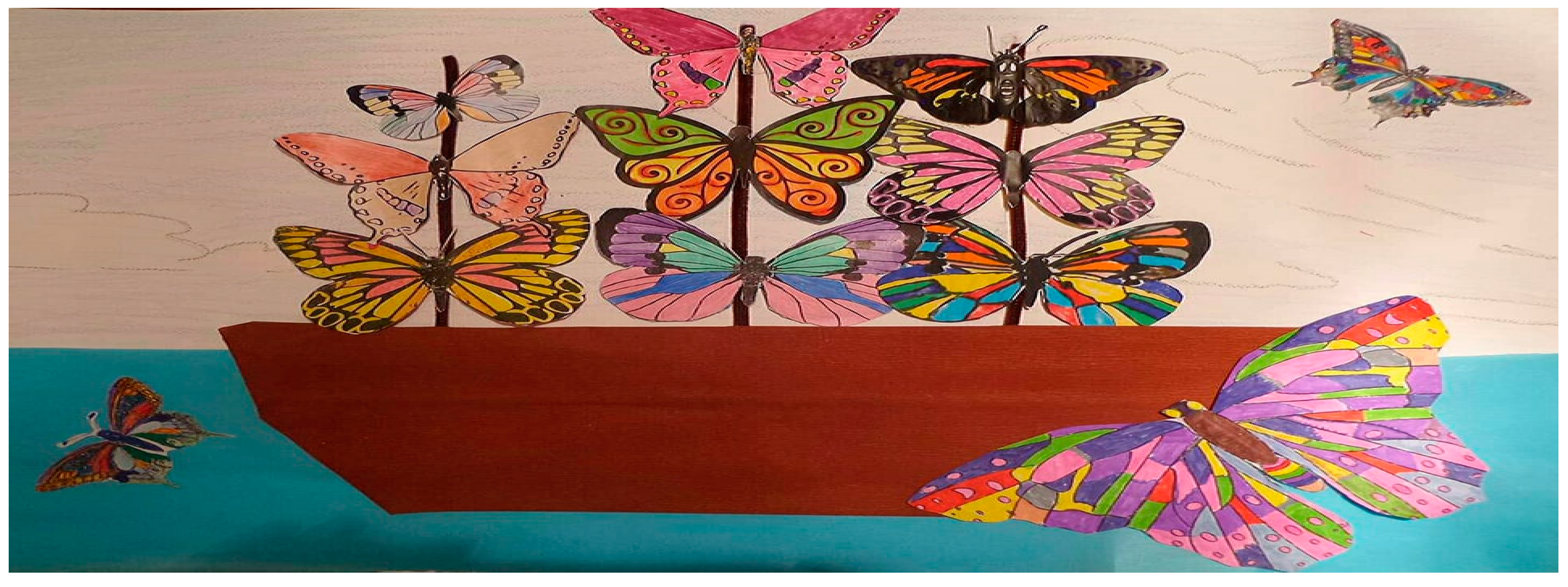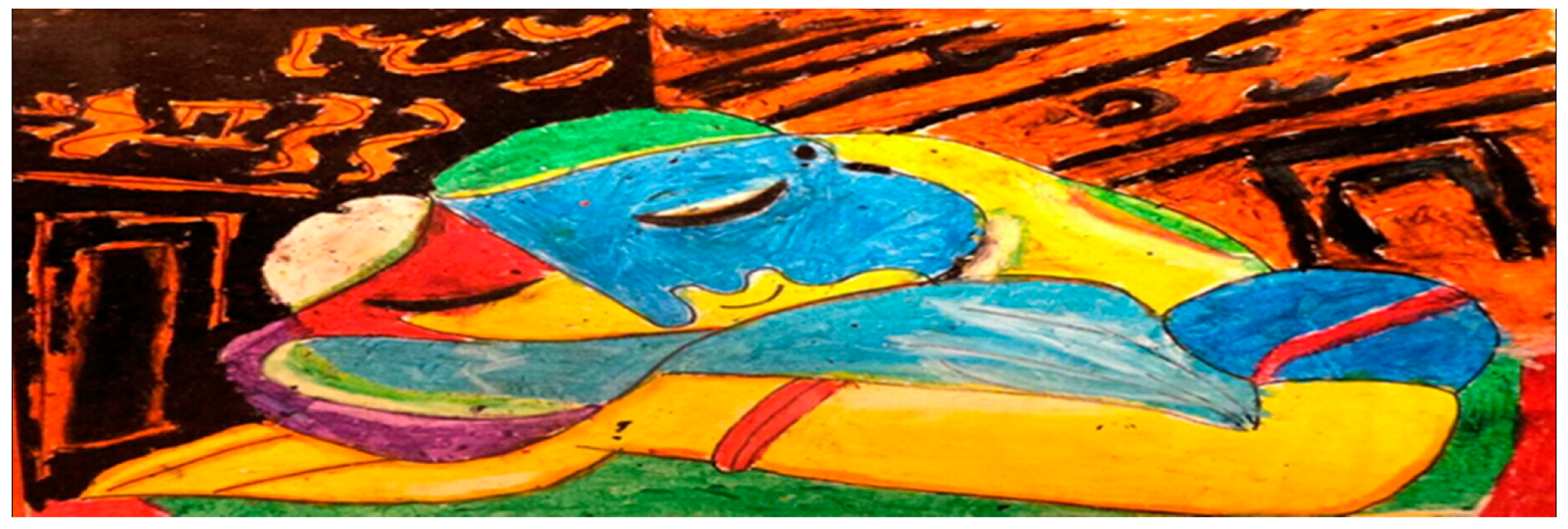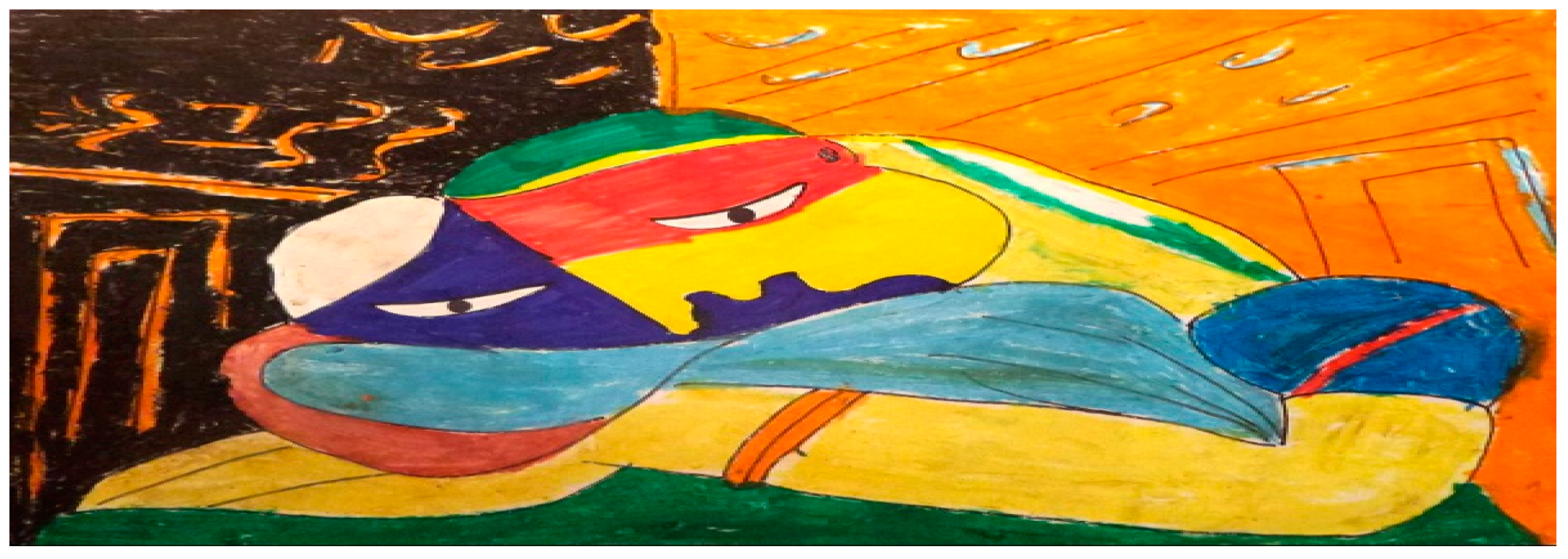Technology and School Unit Improvement: Researching, Reconsidering and Reconstructing the School Context through a Multi-Thematic Digital Storytelling Project
Abstract
:1. Introduction
- How can this multi-thematic digital storytelling project motivate learners’ critical thinking by using higher cognitive levels of thought?
- How can the current project promote the adoption of a teaching approach which takes into consideration the needs and uniqueness of each learner?
- How can the specific project lead to creating collaboration networks within the school unit?
2. Digital Storytelling
3. Methodology
4. Project
4.1. Planning
4.2. Implementation
4.3. Evaluation
5. Results and Discussion
5.1. Critical Thinking
“Actually, the whole process surprised me in a pleasant way. For me, the interest shown by all my students, including those who attend the Integration class, shocked me. For example, Eleni who seemed to have completely lost interest for the learning process, gradually started being activated within the group. After assuming the role of an artist-leader, her ideas about reconstructing the Starry Night painting and the movement of the stars with nails was indeed amazing. The feeling of satisfaction she had after she realized her teacher’s and classmates’ enthusiasm regarding her idea seemed to activate her in the learning process. She felt responsible for the final outcome which, in turn, made her fell precious and indispensable in her class. The feelings of responsibility and satisfaction were so powerful that made her overcome even her biggest fear. Despite her learning difficulties and problems she deals with in writing, she was quite active during scriptwriting…”
“I liked the project very much because we had to think how to do it.”
“Firstly, I did not know what to do. It seemed difficult. Still, as time went by, I began coming up with and rejecting ideas.”
“Today, the second week of coding with the programming language Scratch.2 began. All students seemed to be focused on their goal. Every student started working with the Scratch.2 library, working at his/her own pace and rhythm and considering his/her own preferences. In particular, George managed to write a script where two different sprites move simultaneously. The team leaders are students who seem to be acquainted with Scratch.2 and seem to be engaging with coding in their free time. There were also some students who despite the fact they had difficulty in coding, made suggestions which were considered by the team leader. All students seem to be promoting their ideas, thus creating a collaboration network”.
“In my view, scriptwriting was a process unexpectedly creative and I would dare say moving. Pupils seemed to be sensitized by the paintings and even enchanted by their aesthetic excellence. The second part of the digital story was intended to provoke the audience’s emotions and students made use of everyday routine instants in order to build the script. It reminded me of my childhood. Especially, the combination of music, paintings of these wonderful works of art, the children’s voices with their wonderful narration touched deeply me…”
“The presentation really surprised me. What we watched represents our culture, science, technology, biology and art and sends a clear message of respect which was for me the whole of our gut culture, science, technology, biology and art, oriented to a purpose that is totally on the side of man, since the message of respect for nature is essentially a message about the human future. The feedback given to children and to ourselves is very significant since the approached scientific issues using data drawn by nature”
5.2. Learner Engagement
“What I realized while implementing the project was that the planning stage is of crucial importance. Precision in the planning stage will result in precision in the implementation stage. I began researching what fits each of my students. In the history lesson, I started using more videos and provide students with notes. I used intense visuals since many students were interested in the artistic part and I utilized material form museums I have visited. They liked the idea and their interest was raised…”
“…the digital storytelling project helped me realize that I have to become more inventive and flexible so as to aid each learner to engage in the learning process. The key is not to try out things blindly but take your learners’ personality into account. I began to enrich my lessons with more visuals and videos and I started using drama as a teaching method. Of course, this venture demands work at home but, finally, it is rewarding since you can enjoy an incomparable better lesson which learners enjoy. You must be prepared to apply new things, which even if they do not succeed, reconsider and start building again…”
“…I like Language. It is my favorite subject.”
“…My favorite subject is Science. The teacher makes experiments and we discuss about the lesson. It becomes more pleasant…”
5.3. Collaboration Networks
“…The initial method of group forming failed as the weak students and especially the special integration class students could not work within the groups. However, we were not discouraged. We formed new groups according to the method I mentioned. The new method demanded hard work as we had to prepare the appropriate activities which would promote all learners’ cognitive level within the groups. In order to achieve this, both teachers cooperated on a daily basis while the integration class teacher greatly helped us supporting learners when necessary…”
“Today, the school principal seemed to more resilient in his views in the council. He attentively listened to what teachers suggested regarding piloting the model of co-education and decided to support them”
“To be honest, the project was welcomed by parents, teachers and students which led me to reconsider some of my views. I decided to provide teachers with more freedom so that they act accordingly with their students. Schools should promote learning and this cannot be achieved when knowledge is imposed on the learner. At first, I believed that such innovations cannot be realized in the context of the centralized character of Greek education. However, through the project I realized that the required flexibility can ultimately come through collective action. I will dare to adopt a collaborative course of action so that we can all find ways to creatively build knowledge…”
6. Conclusions
Author Contributions
Funding
Conflicts of Interest
References
- Åberg, Ewa S. 2014. Children’s Story Making with Digital Technologies: Tool-mediated Activities in a Preschool. Bachelor’s Dissertation, University of Gothenburg, Gothenburg, Sweden, September 4. [Google Scholar]
- Ainscow, Mel, Tony Booth, and Alan Dyson. 1999. Inclusion and Exclusion in Schools: Listening to Some Hidden Voices. In Inclusive Education: International Voices on Disability and Justice. Edited by Keith Ballard. London: Falmer Press, pp. 139–51. [Google Scholar]
- Ainscow, Mel, Alan Dyson, Sue Goldrick, and Mel West. 2012. Making Schools Effective for All: Rethinking the Task. School Leadership & Management 3: 197–213. [Google Scholar]
- Barnes, Kassandra, Raymond Marateo, and Pixy Ferris. 2007. Teaching and learning with the net generation. Innovate: Journal of Online Education 3: 1–8. [Google Scholar]
- Booth, Dianna L. 2002. Project Work, 2nd ed. New York: Oxford University Press. [Google Scholar]
- Czarnecki, Kelly. 2009. How digital storytelling builds 21st century skills. Library Technology Reports 45: 15–19. [Google Scholar]
- Dickins, Paulina R., and Kevin Germaine. 2014. Managing Evaluation and innovation in Language Teaching: Building Bridges. London: Routledge. [Google Scholar]
- Dochy, Filip, Segers Mien, Bossche Pit, and Gijbels David. 2003. Effects of problem-based learning: A meta-analysis. Learning and Instruction 13: 533–68. [Google Scholar] [CrossRef]
- Frazel, Midge. 2010. Digital Storytelling: Guide for Educators. Washington: ISTE. [Google Scholar]
- Jenkins, Martin, and Jo Lonsdale. 2007. Evaluating the Effectiveness of Digital Storytelling for Student Reflection. Paper Presented at the Conference, ICT: Providing Choices for Learners and Learning, Singapore, December 2–5. [Google Scholar]
- Kajder, Sara, Glen Bull, and Susan Albaugh. 2005. Constructing Digital Stories. Learning & Leading with Technology 32: 40–42. [Google Scholar]
- Karagianni, Evangelia. 2014. Teacher development and coll@bor@tion. Research Papers in Language Teaching & Learning 5: 87–109. [Google Scholar]
- Karkoulia, Kostoula C. 2016. Teachers’ attitudes towards the integration of Web 2.0 tools in EFL teaching. Research Papers in Language Teaching and Learning 7: 46–74. [Google Scholar]
- Koufadi, Efthymia. 2014. Integrating Computer Mediated Communication (CMC) and Online Networking in the teaching of English as a foreign language in high school. Research Papers in Language Teaching & Learning 5: 199–222. [Google Scholar]
- Kouvara, Theodora, Christoforos Karachristos, Elias Stavropoulos, and Vassilios Verykios. 2018. Children’s Voice and School Improvement: The Role of Technology in the Inclusive School of the Future. Unpublished manuscript, last modified November 13. Microsoft Word File for Croatian Journal of Education. [Google Scholar]
- Kouvara, Theodora, Stavroula Karasoula, Christoforos Karachristos, Elias Stavropoulos, and Vassilios Verykios. 2018. Technology and School Unit Improvement: Researching, Reconsidering and Reconstructing the School Context through a Multi-Thematic Digital Storytelling Project. Paper Presented at the WEI International Academic Conference on Education, Teaching and Learning, Boston, MA, USA, August 1–3. [Google Scholar]
- Lambert, Jameson. 2013. Digital Storytelling: Capturing Lives, Creating Community. London: Routledge. [Google Scholar]
- Lee, Kuang W. 2000. English Teachers’ Barriers to the use of Computer-assisted Language Learning. The Internet TESL Journal 6: 1–8. [Google Scholar]
- Legutke, Michael, Thomas Howard, and Candlin Christopher N. 2014. Process and Experience in the Language Classroom. London: Routledge. [Google Scholar]
- Lincoln, Yonna S., and Egon G. Guba. 1985. Naturalistic Inquiry. Newbury Park: Sage, vol. 75. [Google Scholar]
- Messiou, Katerina. 2006. Conversations with Children: Making Sense of Marginalization in Primary School Settings. European Journal of Special Needs Education 21: 39–54. [Google Scholar] [CrossRef]
- Miles, Matthew, and Michael Huberman. 1994. Qualitative Data Analysis: An Expanded Sourcebook. Arizona State University: Sage. [Google Scholar]
- November, Alan. 2008. Web Literacy for Educators. London: Corwin Press. [Google Scholar]
- Ohler, Jason B. 2006. The world of digital storytelling. Educational Leadership 63: 44–47. [Google Scholar]
- Ohler, Jason B. 2013. Digital Storytelling in the Classroom: New Media Pathways to Literacy, Learning, and Creativity. London: Corwin Press. [Google Scholar]
- Papadopoulou, Sevasti, and Kosmas Vlachos. 2014. Using digital storytelling to develop foundational and new literacies. Research Papers in Language Teaching & Learning 5: 235–58. [Google Scholar]
- Papaefthymiou-Lytra, Sophia. 2014. L2 Lifelong Learning/use and New Media Pedagogies. Research Papers in Language Teaching & Learning 5: 16–33. [Google Scholar]
- Richards, Rhonda T. 1998. Infusing technology and literacy into the undergraduate teacher education curriculum through the use of electronic portfolios. THE Journal (Technological Horizons in Education 25: 46–50. [Google Scholar]
- Robin, Bernard. R. 2008. Digital storytelling: A powerful technology tool for the 21st century classroom. Theory into Practice 47: 220–28. [Google Scholar] [CrossRef]
- Sadik, Alaa. 2008. Digital storytelling: A meaningful technology-integrated approach for engaged student learning. Educational Technology Research and Development 56: 487–506. [Google Scholar] [CrossRef]
- September, Sean C. 2008. Educator Training and Support for Inclusive Education. Ph.D. Dissertation, University of Zululand, Zululand, South Africa, April 16. [Google Scholar]
- Sifakis, Nikos, and Athina Georgoutzou. 2004. Language Leaning Skills &Materials (Oracy and Literacy). Patra: Hellenic Open University. [Google Scholar]
- Singhal, Meena. 1997. The Internet and Foreign language Education: Benefits and Challenges. The Catesol Journal. Available online: http://iteslj.org/Articles/Singhal-Internet.html (accessed on 12 December 2017).
- Teehan, Kay. 2006. Digital Storytelling: In and Out of the Classroom. Available online: https://books.google.gr/books?id=MarAZOtMKC0C&lpg=PA1&ots=XVf7KR0Xtn&dq=).%20Digital%20storytelling%3A%20In%20and%20out%20of%20the%20classroom&lr&hl=el&pg=RA1-PR1#v=onepage&q&f=false (accessed on 2 December 2017).
- Thorne, Richard E., and Garry Thomas. 2007. Herring and the “Exxon Valdez” oil spill: an investigation into historical data conflicts. ICES Journal of Marine Science 65: 44–50. [Google Scholar] [CrossRef]
- United Nations. 1989. Convention of the Rights of the Child. Available online: http://www.un.org/documents/ga/res/44/a44r025.htm (accessed on 10 November 2017).
- Αγαλιώτης, Ιωάννης. 2011. Υποστήριξη Μαθητών με Ειδικές Εκπαιδευτικές Ανάγκες ή Προβλήματα Συμπεριφοράς. Working paper, Department of Educational and Social Policy, National Documentation Centre, University of Macedonia, Thessaloniki. Available online: http://reader.ekt.gr/bookReader/show/index.php?lib=EDULLL&item=1124&bitstream=1124_01#page/1/mode/2up (accessed on 10 November 2017).
- Αγγελίδης, Παναγιώτης. 2012. Εισαγωγή. In Συμπεριληπτική Εκπαίδευση και Βελτίωση Σχολείων: Σχέση αμφίδρομη. Edited by Παναγιώτης Αγγελίδης. Athens: Διάδραση, pp. 11–28. [Google Scholar]
- Αγγελίδης, Παναγιώτης, and Λούση Αβραμίδου. 2011. Ανάπτυξη Συμπεριληπτικής Εκπαίδευσης Μέσα από Άτυπα Περιβάλλοντα Μάθησης. In Παιδαγωγικές της Συμπερίληψης. Edited by Παναγιώτης Αγγελίδης. Athens: Διάδραση, pp. 17–42. [Google Scholar]
- Αγγελίδης, Παναγιώτης, and Μαρία Ευαγγέλου. 2012. Η Εφαρμογή Ενός Συνεργατικού Μοντέλου Έρευνας Δράσης για την Εξέλιξη των Εκπαιδευτικών. In Συμπεριληπτική εκπαίδευση και Βελτίωση σχολείων. Edited by Παναγιώτης Αγγελίδης. Athens: Διάδραση, pp. 31–51. [Google Scholar]
- Αγγελίδης, Παναγιώτης, and Τασούλα Στυλιανού. 2011. Η εκπαίδευση των εκπαιδευτικών στη Συμπεριληπτική Εκπαίδευση. In Παιδαγωγικές της συμπερίληψης. Edited by Παναγιώτης Αγγελίδης. Athens: Διάδραση, pp. 191–218. [Google Scholar]
- Αγγελίδου, Κάτια. 2011. Επιτυχημένη Ηγεσία και Παροχή Ίσων Ευκαιριών Μέσω των Δημοκρατικών Διαδικασιών. In Παιδαγωγικές της Συμπερίληψης. Edited by Παναγιώτης Αγγελίδης. Athens: Διάδραση, pp. 163–90. [Google Scholar]
- Αμανατίδης, Νίκος. 2016. Δημιουργία βραβευμένης εκπαιδευτικής ταινίας μικρού μήκους στα πλαίσια ενός Ευρωπαϊκού Προγράμματος. Paper Presented at the Conference, Η Εκπαίδευση στην Εποχή των Τ Τ.Π.Ε., Athens, Greece, November 5–6. [Google Scholar]
- Αρβανίτη, Ελένη, and Ιωάννης Κατσαρός. 2016. Eνδοσχολική επαγγελματική μάθηση και διαφοροποίηση του διδακτικού σχεδιασμού. Available online: file:///C:/Users/Nora/Desktop/paperArvaKats16OCT15final.pdf (accessed on 24 April 2017).
- Βεγουδάκης, Kώστας. 2016. Χρήση των Νέων Τεχνολογιών για τη Διερεύνηση των Στάσεων και των Αντιλήψεων των Εκπαιδευτικών Αναφορικά με τη Συμπεριληπτική Εκπαίδευση Παιδιών με ή χωρίς Ειδικές Ανάγκες και Αναπηρίες. Master’s Dissertation, University of Western Macedonia, Florina, Greece, June 17. [Google Scholar]
- Βρασίδας, Χαράλαμπος. 2014. Εισαγωγή στην Ποιοτική Έρευνα. Nicosia: Cardet Press. [Google Scholar]
- Δημητριάδης, Σταύρος. 2015. Θεωρίες Μάθησης και Εκπαιδευτικό Λογισμικό. Athens: Εθνικό Μετσόβιο Πολυτεχνείο. [Google Scholar]
- Ισαρη, Φιλία, and Μάριος Πουρκός. 2015. Ποιοτική Μεθοδολογία Έρευνας: Εφαρμογές στην Ψυχολογία και στην Εκπαίδευση. Athens: Σύνδεσμος Ελληνικών Ακαδημαϊκών Βιβλιοθηκών, Available online: https://repository.kallipos.gr/handle/11419/5826 (accessed on 4 December 2017).
- Κλινάκη, Χρυσή. 2012. Ανάπτυξη Πολυμεσικού Λογισμικού και Πρακτική Εφαρμογή του σε Μαθητές Δημοτικού. Bachelor’s Dissertation, Technological Educational Institute of Crete, Crete, Greece, May 27. [Google Scholar]
- Μακράκης, Βασίλειος. 2000. Υπερμέσα στην Εκπαίδευση. Μια κοινωνικο–εποικοδομιστική προσέγγιση. Αthens: Μεταίχμιο. [Google Scholar]
- Ματσαγγούρας, Ηλίας. 2003. Η σχολική τάξη: Χώρος, Ομάδα, Πειθαρχία, Μέθοδος. Athens: Γρηγόρη. [Google Scholar]
- Παπαναστασίου, Ελένη. 2017. Μέτρηση και Αξιολόγηση στην Εκπαίδευση. Λευκωσία: ιδιωτική. [Google Scholar]
- Στασινός, Δημήτριος. 2016. Η Ειδική Εκπαίδευση 2020 PLUS. Για μια Συμπεριληπτική ή Ολική Εκπαίδευση στο Νέο-ψηφιακό Σχολείο με Ψηφιακούς Πρωταθλητές. Athens: Παπαζήση. [Google Scholar]
- Τσιώλης, Γεώργιος. 2015. Ανάλυση ποιοτικών δεδομένων: διλήμματα, δυνατότητες, διαδικασίες. In Ερευνητική Μεθοδολογία στις Κοινωνικές Επιστήμες και στην Εκπαίδευση. Συμβολή στην Επιστημολογική Θεωρία και την Ερευνητική Πράξη. Edited by Γιάννης Πυργιωτάκης and Χρήστος Θεοφιλίδης. Athens: Πεδίο, pp. 473–98. [Google Scholar]
- Χασσάνδρα, Μαρία, and Μάριος Γούδας. 2003. Κριτήρια εγκυρότητας και αξιοπιστίας στην ποιοτική-ερμηνευτική έρευνα. Available online: http://lab.pe.uth.gr/psych/images/stories/pdf/various/kritiria_egyrotitas_kai_aksiopistias_stin_poiotiki_ereyna.pdf (accessed on 5 January 2018).
| 1 | The term “critical thinking” used in the current study refers to the activation of the higher cognitive processes of thought, such as analysis, synthesis, and the evaluation of a concept (Thorne and Thomas 2007.) |
| 2 | New literacies refer to digital literacy (the ability to find, evaluate, utilize, share, and create content using information technologies and internet), media literacy (the ability to synthesize, analyze, and produce mediated messages), visual literacy (the ability to interpret, negotiate, and make meaning from information presented through an image), information literacy (the ability to find, evaluate, and synthesize information), and global literacy (the ability to read, interpret, respond, and contextualize messages from a global perspective (November 2008). |
| 3 |










© 2019 by the authors. Licensee MDPI, Basel, Switzerland. This article is an open access article distributed under the terms and conditions of the Creative Commons Attribution (CC BY) license (http://creativecommons.org/licenses/by/4.0/).
Share and Cite
Kouvara, T.K.; Karasoula, S.A.; Karachristos, C.V.; Stavropoulos, E.C.; Verykios, V.S. Technology and School Unit Improvement: Researching, Reconsidering and Reconstructing the School Context through a Multi-Thematic Digital Storytelling Project. Soc. Sci. 2019, 8, 49. https://doi.org/10.3390/socsci8020049
Kouvara TK, Karasoula SA, Karachristos CV, Stavropoulos EC, Verykios VS. Technology and School Unit Improvement: Researching, Reconsidering and Reconstructing the School Context through a Multi-Thematic Digital Storytelling Project. Social Sciences. 2019; 8(2):49. https://doi.org/10.3390/socsci8020049
Chicago/Turabian StyleKouvara, Theodora K., Stavroula A. Karasoula, Christoforos V. Karachristos, Elias C. Stavropoulos, and Vassilios S. Verykios. 2019. "Technology and School Unit Improvement: Researching, Reconsidering and Reconstructing the School Context through a Multi-Thematic Digital Storytelling Project" Social Sciences 8, no. 2: 49. https://doi.org/10.3390/socsci8020049
APA StyleKouvara, T. K., Karasoula, S. A., Karachristos, C. V., Stavropoulos, E. C., & Verykios, V. S. (2019). Technology and School Unit Improvement: Researching, Reconsidering and Reconstructing the School Context through a Multi-Thematic Digital Storytelling Project. Social Sciences, 8(2), 49. https://doi.org/10.3390/socsci8020049




